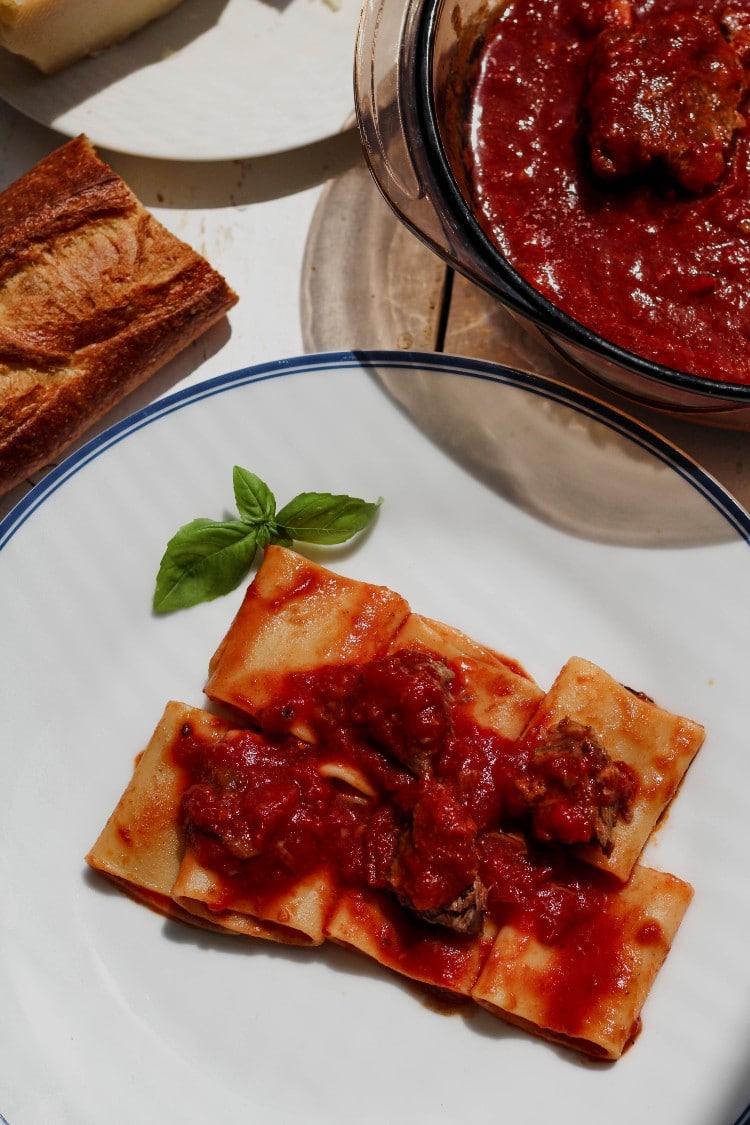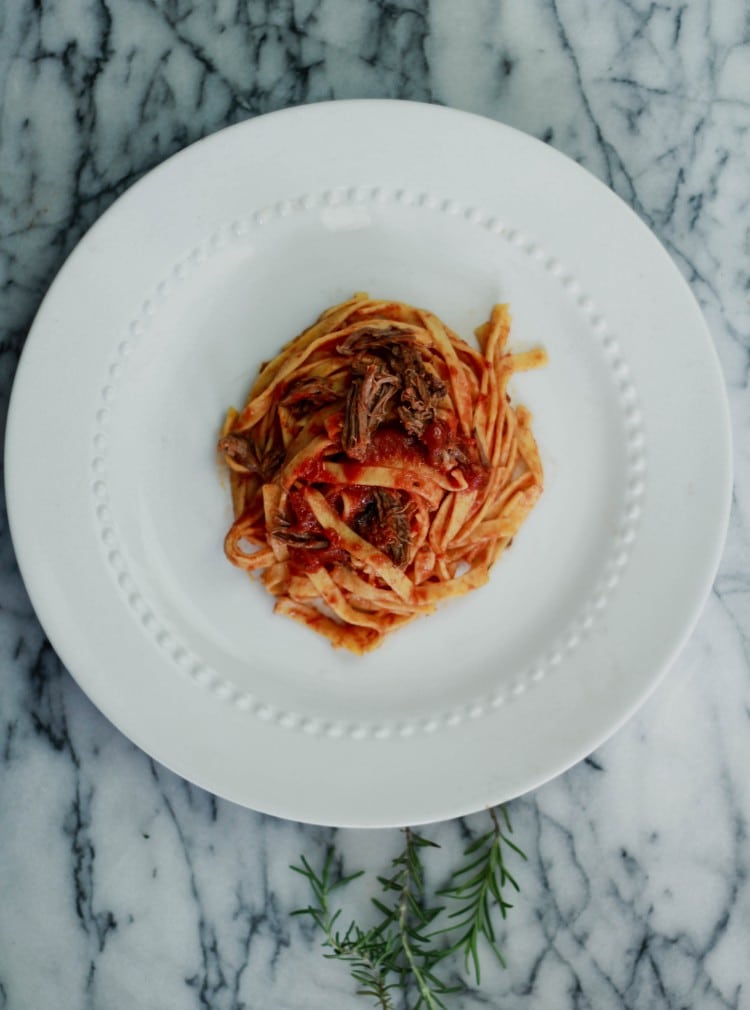Slow Cooked Beef Short Ribs Sauce features ribs slowly braised with carrots, onions, celery, fresh herbs, red wine and tomato sauce. The beef short ribs are cooked until they melt in your mouth. You may know this Italian sauce as a Sunday gravy, a ragù napoletano, or as I call it, mom’s Sunday sauce. Total Italian comfort food in every bite!
This sauce made with ribs that literally fall apart they’re so tender, serves 8 and freezes really well! It’s a perfect recipe to prep ahead and reheat when you’re ready to serve. It actually gets better with when you reheat it! This delicious sauce is sugar-free, dairy-free, and naturally gluten-free.
Of all the Italian recipes, a ragù is one of my top recipes I love to cook (and to eat!). Il ragù napoletano, and in Napoletano dialect: ’O rraù. You maybe know this is short beef ragu’, Sunday gravy or what we would call it, mom’s Sunday sauce.
Just the aroma of this sauce simmering away transports me back to my childhood kitchen. I love making a ragù with ground meats and also with the bone-in ribs, like we do here in this recipe. This sauce is one of the recipes that expresses the simplicity of Italian cooking and the magic that is made with simple ingredients.
But it’s also the process. There is no rushing making an amazing ragù. So with patience, time, and amore, you will also make an incredible ragù!
This is is a classic Italian dish where you’ll find it made in Naples (and in different regions of Italy). My mom taught me how to make it the way she learned how to make it, and most likely, you’ve seen different versions of the sauce.
From what I learned from some authentic cooks in Naples, Italy, is that you have to slowly simmer it for 6 hours. I usually simmer mine for about 4 hours and sometimes, 5-6 hours (depending on which meat I’m using). The longer it simmers, the more the flavors melt and the richer the sauce becomes. Also, the meat just falls off the bone.
Can I use sausage in this sauce?
Yes, there are versions of this sauce with the beef bone-in ribs (or pork ribs), pieces of pork and also sausage. Sometimes my mom (nonna)makes it with the ribs and meatballs (that's my kids favorite way to have this sauce!). You can do a combo of whatever you like. I typically do mine with just the ribs.
Why we love a short rib sauce so very much:
Slowly simmered: This is the best part of the sauce. Time and patience creates the most magical sauce.
Totally rich and satisfying: Braises ribs slowly cooking with the splash of red wine, the seasonings and the sauce, turns into a sauce that is as smooth as velvet.
Impress guests: This is the sort of sauce that your pot or the slow cooker will do all the work. If you're making stove top, it just will need stirring while it’s simmering. Really lovely for a holiday (Christmas or even for Valentine’s Day).
The main ingredients in the sauce:
• English cut beef short ribs: I always choose ribs with some marbling, and they’re always super flavorful and more tender.
• The veggies: onion, carrot, & celery. I like keeping my carrots and celery in big piece for this rustic sauce, but feel free to chop them (you could even do it in a food processor). I do chop the onions in small pieces.
• Herbs : A combination of fresh and dried herbs is a part of the magical flavoring of this simple and rustic sauce. I use fresh rosemary (or my own rosemary from the garden that I have dried) and sage (but you could use just rosemary). I also add in some dried bay leaves.
Wine – Always remember to use a wine that you would actually drink. We usually have an opened red on the counter and I use whatever is leftover in that bottle (most likely a nice Chianti).
• Tomatoes – I prefer to use a smooth tomato sauce, but fee free to use San Marzano tomatoes. Just be sure to blitz them in a blender to make it smooth. There is no need for tomato paste, as this sauce thickens up so much as it slowly cooks and simmers.
BEEF SHORT RIBS
In Italy, they do make this recipe with pork or beef. I prefer to make it with beef ribs. You may be new to cooking with beef ribs. You could come across the English-cut beef short ribs or the flanken beef short ribs. Flanken beef short ribs are long strips of the beef and better to use for a quick recipe.
It’s best to use the English cut as it is the beef cut along the bone, and it benefits from slowly cooking and simmering. And the longer you let it simmer, the more fall-apart tender it will become.
I prefer bone-in ribs, but boneless short ribs are really easy to shred into large pieces once you’re done braising them. Honestly, get whatever you find that is on sale (bone-in or boneless, either one will do fine in the recipe!).
Other short rib sauce cooking methods
I love to make this sauce stove top in my Dutch oven, but you can use whatever large sauce pan you have. I've seen some people even make it in a very deep and large skillet. The slow cooker is my second favorite way to cook it!
Can I make Italian rib sauce in the oven?
Yes, it’s really easy to make in the oven. Just braise the meat in the skillet and then add the meat, sauce and other ingredients to an oven proof pot (like a Dutch oven)or a deep pan. It could take 2-3 hours in the oven on 350F. Stir it every 30 minutes or so and once the ribs start to fall off the bone, it’s ready.
Can I make short rib sauce in a slow cooker (Crockpot)?
Yes, I really love to make this sauce in my Crockpot!
Just like the method of making in the oven, you have to first braise the ribs in a skillet.
Add in the veggies, herbs, wine to the skillet with the ribs. Cook together for a few minutes then add every thing from the skillet into the slow cooker. Add the sauce and stir it around the ribs. Add in 3/4 cup to 1 cup water, stir it together. Close with the lid and cook on high for 4-5 hours or on low for 7-8 hours, stirring occasionally.
Serve with cooked pasta or with polenta.
Can I make rib sauce in the Instant Pot?
Yes, you can make in a pressure cooker/Instant Pot, but honestly, I prefer the other cooking methods.
You’ll have to still braise the ribs (you could do in your Instant Pot or stove top in a skillet).
Add the ribs to the bottom of the Instant Pot and layer in the other ingredients and the sauce (plus the seasonings). Set your Instant Pot to Pressure cook on High and set the timer for 40 minutes. Make sure the venting valve is closed.
As soon as it’s finished pressure cooking, let it steam naturally for 10 minutes, and then release the remaining steam by turning the steaming valve to open.
Carefully remove the ribs and select SAUTÉ on High and bring the sauce to a simmer. Skim out the grease that forms on top with a spoon.
Some final tips and notes on this recipe:
- The beef short ribs: The ribs are the star of the recipe. I always choose bone-in, but feel free to use boneless. You could also use pork instead of meat (as I mention above).
- The olive oil: I use a really good quality Sicilian extra-virgin olive oil. It is nice and fruity and adds great flavor to every recipe I make with it.
- Braising the meat: Take your time and get the perfect brown color on both sides. You may have to do it in batches (depending on size of your skillet)
- The sauce: Like the olive oil, I spend a little bit more and get a good quality tomato sauce (I typically make this with Italian strained tomatoes, you can find them now in every market or for sure, online), but go ahead and buy whole Italian San Marzano tomatoes. You could blend them or even crush them with a fork (or break them up with your hands, be sure to remove the white tough insides).
- The wine: I usually have a red wine on hand with about 1/2 cup-1 cup leftover. That’s usually what will get added to my rich sauces like this one. The alcohol evaporates when it cooks and what’s left is a beautiful dimension to the sauce flavor.
- The pasta: I make this with paccheri, penne, spaghetti, tagliatelle, and pappardelle. Most recently I’ve been making it usually with rigatoni. Penne would work fine too! My husband is from the polenta region of Italy, so many times, we have this with polenta, instead of pasta.
- The cheese: Serve with some grated Parmigiana Reggiano or pecorino on top. If you're dairy-free, there are some nice dairy-free grated cheeses that you could use.
Make-Ahead, Storage & Freezing:
Short rib sauce is a wonderful recipe to make ahead. The sauce flavors do get better with time (I prefer it when it’s reheated…the flavors taste even richer than when it’s first cooked, similar to like what happens when you reheat a beef stew). Super easy to store and to freeze.
How to store short rib sauce?
Beef short rib ragu sauce stores very well! To store: simply let the sauce completely cool down and place in an airtight container in the refrigerator. Store in fridge for up 4-5 days.
How to reheat rib sauce?
When you’re ready to enjoy the sauce again, simply place it in a skillet or sauce pan and slowly heat it up on medium low. Cook your pasta and toss with the sauce.
How to freeze short rib sauce?
This is a very freezer-friendly Italian sauce. Once the sauce has completely cooled down, if the meat didn’t already fall off the bones, cut the meat off the bones, and place the sauce and meat in airtight containers (you could do multiple smaller containers or a couple of larger ones).
Freezes well for up to 3 months. To serve from frozen: Leave portion of sauce in fridge over night. Next day, reheat sauce in a sauce pan on medium low. Let it slowly heat it up and come to a simmer.
Some other delicious sauces to try:
Slow Cooked Beef Short Ribs Sauce
Ingredients
- 4 pounds English cut beef short ribs
- 2 Tablespoons extra-virgin olive oil
- 3 large carrots peeled
- 3 stalks celery cleaned, ends cut off
- 1 large onion finely diced
- 1 cup dry red wine optional
- 2 sprigs fresh rosemary
- 2 sprigs fresh sage leaves
- 2 bay leaves
- Two 24-oz. jars Italian strained tomatoes or two 28-oz. cans of Italian San Marzano tomatoes, crushed by hand
- 1-2 cups water
- sea salt & ground black pepper to season
- pasta: 1 lb tagliatelle pappardelle, paccheri, or pasta of choice
Instructions
- Brown the short ribs: Season short ribs liberally with salt and pepper. You'll need about two teaspoons,
- Heat a large Dutch oven or heavy-bottomed pot to a medium-high heat. Add olive oil. As soon as the oil is shimmering hot, add in the ribs.
- Cook the ribs in batches so they’re not crowded. Should take about 4 minutes per side to get the nice and brown color. If there is a lot of drippings, remove some and leave about 2 tablespoons in the pot.
- Cook the veggies: Add in the onions, carrots, and celery. Season with a teaspoon of salt and some black pepper (if you like). Cook until the onion is translucent.
- Herbs: Add in the herbs and bay leaves (I usually have some fresh rosemary and sage on hand or even dried rosemary and sage. You could use just rosemary if that’s all you have on hand).
- Deglaze: Add in the red wine (if you’re using). If you don’t have any wine on hand, you could add a cup of beef broth. Turn the heat to medium-high. Use your wooden spoon to stir and scrape any brown bits from the bottom of the pan. Let it cook until most of the wine has cooked down with the brown bits and the onion mixture.
- Sauce: Now is the time to add in the tomato sauce. Use your wooden spoon to carefully stir it around the ribs. Lower the heat to medium-low to let it slowly simmer. I usually make this with strained tomatoes in a glass jar. I pour in the sauce and then add water to fill about 1/2-3/4 full in bottle and shake it to get the sauce that’s on the bottom of the jar. I add that watery tomato sauce to the pot and stir together.
- Simmer: In a large pot (or Dutch oven), the rib sauce will cook for 3-4 hours (or longer) until the ribs pulls away from the bones and are very tender. Check the sauce, stirring occasionally, and add a little bit more water if it’s thickening too much. Every oven is different. If the temperature is too low and it’s not simmering, raise the temperature a little. Keep checking on the sauce and stirring, raising the heat a little, until it gets to a nice simmer.
- Finish the rib sauce: Remove the pot from the burner and place the pot on top of the counter on top of something to protect your counter from the hot bottom of the pan. Remove herbs and the bay leaves. Use tongs or a large metal spoon to remove the ribs. Depending on long you cooked the sauce, the meat may have already removed from the bone. In any case, remove all the bones and the meat.
- Place the meat on a cutting board and use a fork and knife or two forks to shred it into bite-sized pieces.
- Place the rib bites back into the pot with the sauce.
- Cook the pasta: If you’re serving with pasta, cook the pasta according to directions on the box. Drain the pasta a little bit before al dente, and place the pasta in a large skillet with the sauce. Stir it to combine and add a drizzle of olive oil. Serve with grated Parmigiano Reggiano or pecorino.
Nutrition Disclaimer
Please keep in mind that the nutritional information presented below is an approximation and may vary depending on the exact ingredients used.
Notes
Thaw: Leave the frozen sauce overnight in the refrigerator. The next day, heat up the sauce in a skillet. There may be some water from thawing out. If sauce seems too thick while it’s heating up, add a bit of water to loosen it up. Serve heated sauce with pasta or polenta.










Jennifer Cavaiani says
I was only able to find the large beef ribs. Will that still work with this recipe?
Lora says
Hi Jennifer-It should be ok...It may need a bit more time to cook and get tender. Not sure on the exact time, but check it and simmer it longer if it needs it.
Jennifer Cavaiani says
Thanks for the info. I’m just now making the dish. Surprised to realize there’s no garlic involved. Can’t wait to give it a try
Lora says
Hi Jennifer-Ok, hope you enjoyed (even without garlic!). 🙂
Celeste Gascal says
Are the celery and carrots really supposed to remain in chopped?
Lora says
Hi Celeste-I left whole, but you could certainly chop. Either is fine.
Ksthymac28 says
Why no garlic? And can I use two jars of Passats?
Lora says
Why no garlic? That's the way this recipe is...use garlic, if that's what you prefer:) Use two jars of passata if you prefer. Enjoy!